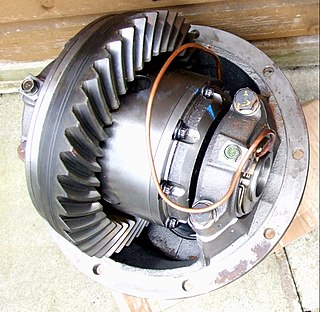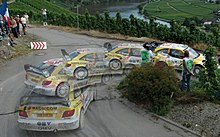Left-foot braking is the technique of using the left foot to operate the brake pedal in an automobile, leaving the right foot dedicated to the throttle pedal. It contrasts with the practice of using the left foot to operate the clutch pedal, leaving the right foot to share the duties of controlling both brake and gas pedals.

Opposite lock, also commonly known as countersteer, is a colloquial term used to mean the steering associated with the deliberate use of oversteer to turn a vehicle rapidly without losing momentum. It is typified by the classic rallying style of rear-wheel drive cars, where a car travels around a bend with a large drift angle. The terms "opposite lock" and "counter-steering" refer to the position of the steering wheel during the maneuver, which is turned in the opposite direction to that of the bend.
A traction control system (TCS), is typically a secondary function of the electronic stability control (ESC) on production motor vehicles, designed to prevent loss of traction of the driven road wheels. TCS is activated when throttle input and engine power and torque transfer are mismatched to the road surface conditions.
Understeer and oversteer are vehicle dynamics terms used to describe the sensitivity of the vehicle to changes in steering angle associated with changes in lateral acceleration. This sensitivity is defined for a level road for a given steady state operating condition by the Society of Automotive Engineers (SAE) in document J670 and by the International Organization for Standardization (ISO) in document 8855. Whether the vehicle is understeer or oversteer depends on the rate of change of the understeer angle. The Understeer Angle is the amount of additional steering that must be added in any given steady-state maneuver beyond the Ackermann steer angle. The Ackermann Steer Angle is the steer angle at which the vehicle would travel about a curve when there is no lateral acceleration required.
Automobile handling and vehicle handling are descriptions of the way a wheeled vehicle responds and reacts to the inputs of a driver, as well as how it moves along a track or road. It is commonly judged by how a vehicle performs particularly during cornering, acceleration, and braking as well as on the vehicle's directional stability when moving in steady state condition.

A locking differential is a mechanical component, commonly used in vehicles, designed to overcome the chief limitation of a standard open differential by essentially "locking" both wheels on an axle together as if on a common shaft. This forces both wheels to turn in unison, regardless of the traction available to either wheel individually.

Electronic brakeforce distribution or electronic brakeforce limitation (EBL) is an automobile brake technology that automatically varies the amount of force applied to each of a vehicle's wheels, based on road conditions, speed, loading, etc, thus providing intelligent control of both brake balance and overall brake force. Always coupled with anti-lock braking systems (ABS), EBD can apply more or less braking pressure to each wheel in order to maximize stopping power whilst maintaining vehicular control. Typically, the front end carries more weight and EBD distributes less braking pressure to the rear brakes so the rear brakes do not lock up and cause a skid. In some systems, EBD distributes more braking pressure at the rear brakes during initial brake application before the effects of weight transfer become apparent.

Drifting is a driving technique where the driver intentionally oversteers, with loss of traction, while maintaining control and driving the car through the entirety of a corner or a turn. The technique causes the rear slip angle to exceed the front slip angle to such an extent that often the front wheels are pointing in the opposite direction to the turn. Drifting is traditionally performed using three methods: clutch kicking, weight transfer, and employing a handbrake turn. This sense of drift is not to be confused with the four wheel drift, a classic cornering technique established in Grand Prix and sports car racing.
A bootleg turn is a driving maneuver intended to reverse the direction of travel of a forward-moving automobile by 180 degrees in a minimum amount of time while staying within the width of a two-lane road. This maneuver is also known as a smuggler's turn, powerslide, or simply bootlegger.

Trail braking is a driving and motorcycle riding technique where the brakes are used beyond the entrance to a turn (turn-in), and then gradually released. Depending on a number of factors, the driver fully releases brake pressure at any point between turn-in and the apex of the turn.

Fishtailing is a vehicle handling problem which occurs when the rear wheels lose traction, resulting in oversteer. This can be caused by low-friction surfaces. Rear-drive vehicles with sufficient power can induce this loss of traction on any surface, which is called power-oversteer.

In road vehicles, the parking brake, also known as a handbrake or emergency brake (e-brake), is a mechanism used to keep the vehicle securely motionless when parked. Parking brakes often consist of a pulling mechanism attached to a cable which is connected to two wheel brakes. In most vehicles, the parking brake operates only on the rear wheels, which have reduced traction while braking. The mechanism may be a hand-operated lever, a straight pull handle located near the steering column, or a foot-operated pedal located with the other pedals.
Lift-off oversteer is a form of sudden oversteer. While cornering, a driver who closes the throttle, usually at a high speed, can cause such sudden deceleration that the vertical load on the tires shifts from rear to front, in a process called load transfer. This decrease in vertical load on the rear tires in turn decreases their traction by lowering their lateral force, making the vehicle steer more tightly into the turn. In other words, easing off the accelerator in a fast turn can cause a car's rear tires to loosen their grip so much that the driver loses control and drifts outwards, even leaving the road tailfirst.

A J-turn is a driving maneuver in which a reversing vehicle is spun 180 degrees and continues, facing forward, without changing direction of travel. The J-turn is also called a "moonshiner's turn", a "reverse 180", a reverse flick, a "Rockford Turn", a "Rockford Spin", or simply a "Rockford" popularized by the 1970s TV show The Rockford Files. A J-turn differs from a bootleg turn in that the vehicle begins in reverse gear. It is often performed by stunt drivers in film and television shows. It can be performed both on dry and snowy surfaces; the latter is preferable while learning the skill.

The Scandinavian flick is a technique used predominantly in ice racing and rallying. The technique induces oversteer using weight transfer to carry a vehicle through a turn while simultaneously reducing speed.
A wheelspin occurs when the force delivered to the tire tread exceeds that of available tread-to-surface friction and one or more tires lose traction. This leads the wheels to "spin" and causes the driver to lose control over the tires that no longer have grip on the road surface. Wheelspin can also be done intentionally such as in drifting or doing a burnout.
All Wheel Control (AWC) is the brand name of a four-wheel drive (4WD) system developed by Mitsubishi Motors. The system was first incorporated in the 2001 Lancer Evolution VII. Subsequent developments have led to S-AWC (Super All Wheel Control), developed specifically for the new 2007 Lancer Evolution. The system is referred by the company as its unique 4-wheel drive technology umbrella, cultivated through its motor sports activities and long history in rallying spanning almost half a century.

A marathon carriage is a modern metal carriage that is used for driving competitions, especially combined driving. It is named after the cross-country phase of a combined driving event which, though inaccurate, became known as the "marathon" phase. The carriage is designed for safety and carries a driver plus one or two assistants, called grooms. Drivers direct the horses while grooms counterbalance the carriage on tight turns, and are available for assistance with the horses in case of an overturn or collision, or equipment malfunction.
An automobile skid is an automobile handling condition where one or more tires are slipping relative to the road, and the overall handling of the vehicle has been affected.
The brake balance or brake bias of a vehicle is the distribution of brake force at the front and rear tires, and may be given as the percentage distributed to the front brakes or as the ratio of front and rear percentages. The braking balance affects the driving characteristics in terms of how fast the vehicle can brake, how the vehicle can take corners, and tire wear. The optimal brake balance can vary between circuits, weather conditions and driving styles. On race cars, the brake balance is often part of the racing setup, and in formula car racing it is regularly adjusted during the course of an entire lap. In some cases, the brake balance may be adjusted to match the traction (grip) of the vehicle during braking, which usually means distributing a greater braking force to the front. In other cases, it may be desirable for the brake balance to be the more similar at the front and rear for the tires to last longer, which may be beneficial in endurance racing. Adjustment of the brake balance is often done by adjusting a proportioning valve which determines the distribution of the brake force between the front and rear brakes. The adjustment can be made via mechanical couplings or with the help of a small electric motor.










